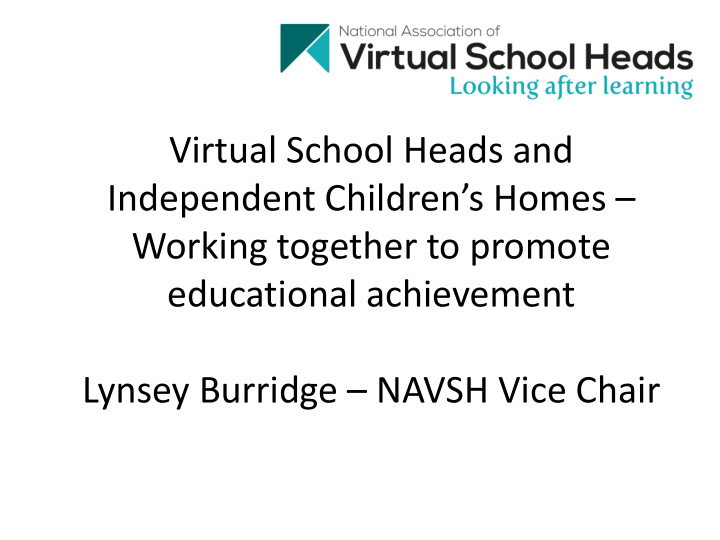



Virtual School Heads and Independent Children’s Homes – Working together to promote educational achievement Lynsey Burridge – NAVSH Vice Chair
The role of the Virtual School Head • The Virtual School Head role was successfully piloted by eleven authorities for two years between 2007 and 2009. • The evaluation of the pilots found that the Virtual School Head role can make a real difference • Virtual School Head became a statutory role in 2014 • The Children and Social Work Act 2017: Educational Achievement extends the duties of Local authorities and Schools to children who have left care through adoption (or Special Guardianship/Child Arrangement Orders) • Statutory Guidance has now been published for Local Authorities and Schools which states that VSHs should ensure that “providers of fostering services and residential care have a robust evidence base that demonstrates they prioritise the educational achievement of looked after children and help them to achieve their full potential” • Statutory Guidance for Schools states that they need to work with residential care staff, ensuring there are procedures in place for communication and that staff are made aware of relevant school processes and policies
What is the current position regarding LAC in schools?
What is the current position regarding LAC in schools?
What is the current position regarding LAC in schools? • Impact of a fragmented educational experience • Impact of early experiences (62% of children enter care due to abuse or neglect) • High incidence of SEN (61% of looked after children compared to 15% of all children – and far more likely to be social, emotional and mental health needs) • Disproportionate amount of fixed term and permanent exclusions – independent review of exclusions practice will include both looked-after and previously looked- after children • Looked after children are almost twice as likely to be permanently excluded as their non-looked after peers, 0.14 per cent compared to 0.07 per cent of non-looked after children • Looked after children are more than five times more likely to have a fixed period exclusion than all children, and more than one and a half times more likely than children in need
The Educational Progress of Looked After Children in England: Linking Care and Educational Data What are the key factors contributing to the low educational outcomes of young people in care in secondary schools in England? The analysis reveals that controlling for all factors, the following contribute to the educational progress of young people in care: P lacement type. Young people living in residential or another form of care at age 16 scored over six grades less than those who were in kinship or foster care. Further Information To find out more about the research: http://reescentre.education.ox.ac.uk/research/educational-progress-of-looked- after-children/
School Admissions • Statutory Guidance for Local Authorities suggests that wherever possible when a child moves placement their school placement should be maintained • Statutory Guidance for Local Authorities suggests that, when a child moves placement in an emergency, a new school placement should be secured within 20 days • Any decision about a new school placement should be made in consultation with the VSH • Schools judged to be ‘good’ or ‘outstanding’ should be prioritised and unless there are exceptional evidence-based reasons looked after children should never be placed in a school judged by Ofsted to be ‘inadequate’ • The School Admissions Code – Looked After Children have the highest priority within all maintained schools’ admission arrangements and are an excepted group from Infant Class Size Legislation. • In-Year admissions – the VSH can direct a maintained school to admit a looked after child even if this takes them over published numbers. The VSH must refer the case to the EFA in order to pursue a ‘direction’ of an academy. • Only 22 cases have been referred to the EFA. There have been no cases where the EFA has concluded that the school should not be directed to admit.
Attachment awareness in schools • Statutory Guidance states that Designated teachers should work with Virtual School Heads and (where available) schools leads for mental health to ensure all school staff have the skills to: • Identify signs of potential mental health issues and how to access further assessment and support (including making use of SENCO and LA support teams) • Understand the impact trauma, attachment disorders and other mental health issues can have on looked-after and previously looked-after children • Designated teachers should work with senior leaders, parents and carers to put in place mechanisms for understanding the emotional and behavioural needs of previously looked-after children. • See also Transforming children and young people’s mental health provision: a green paper • The Alex Timpson Attachment and Trauma Programme in Schools • NICE Guidance: Children’s Attachment – www.nice.org.uk/guidance/ng26 • ARC – The Attachment Research Community • Attachment Aware Schools Programme - www.bathspa.ac.uk/education/research/attachment-aware- schools
Getting to know the VSHs in LAs placing Engaging in the PEP process children with you How do we support you to ensure you have “a robust evidence base that demonstrates you prioritise the educational achievement of looked after children and help them to achieve their full potential”? Sharing education policies, processes and training between Virtual Schools and Residential Children’s Homes
Recommend
More recommend